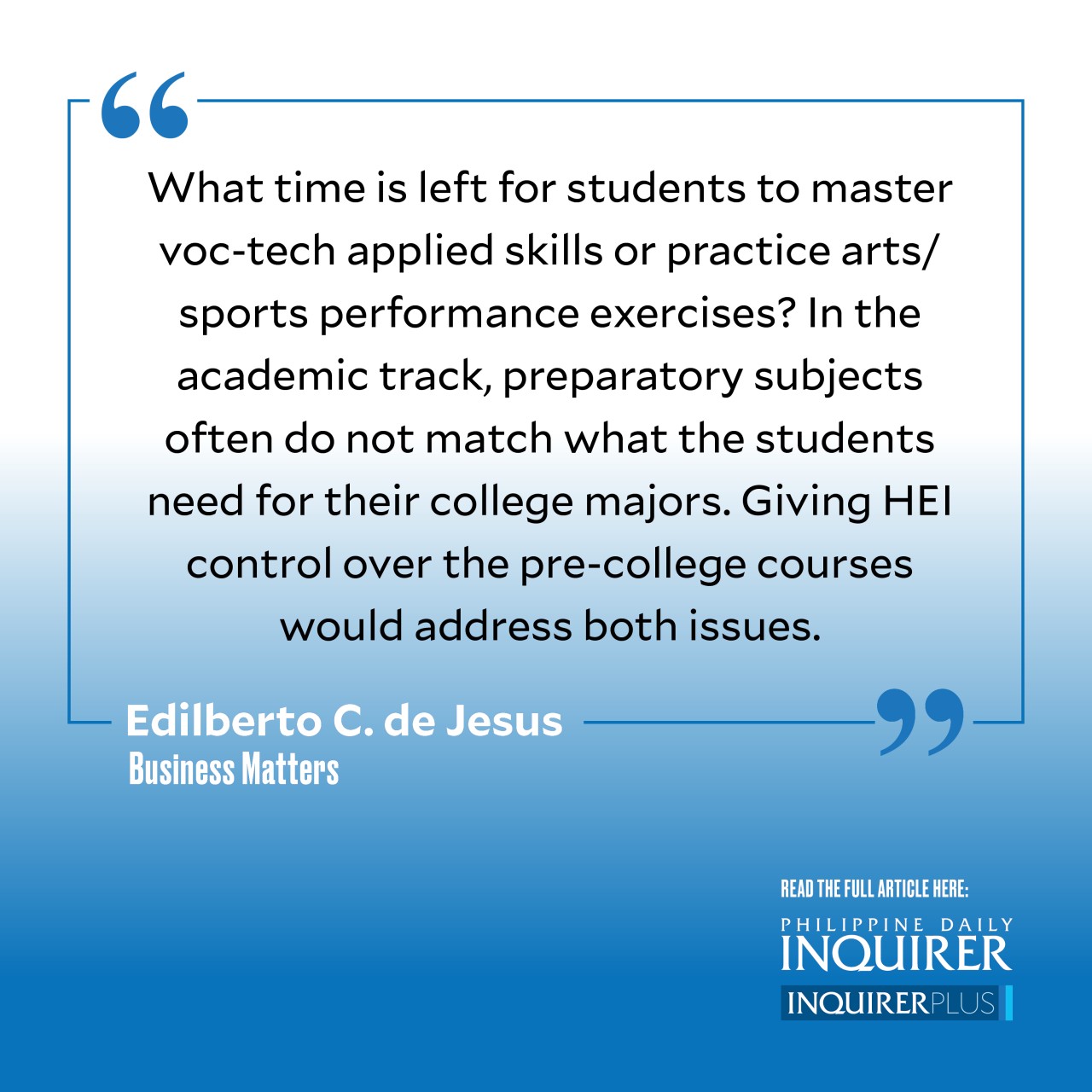Rebranding senior high school

Perhaps, Congress can still rescue the K+10+2 bill proposed by Arroyo to replace K-12. It can support the plan to award K-10 graduates of junior high school (JHS) a diploma that certifies their completion of secondary education and their qualification to move to higher education, the system that prevailed under the K-10 regime. Republic Act No. 10533 (2013) added to the basic education cycle the two years of senior high school (SHS) that students must pass to merit recognition as high school graduates.
The Arroyo bill would deny the +2 option for K-10 graduates not headed to college for studies in STEM (science, technology, engineering, math) disciplines or professions requiring licensure exams. Passing the bill would impose a law that translates to K+10-2 for perhaps half of the K-10 graduating cohort. Does Congress want to reduce the number of K-10 graduates eligible for an additional two years of formal education?
Before K-12, about 40 percent of high school graduates dropped out of the formal education system. In school year 2016 to 2017, the first year of K-12, about half a million more students enrolled in Grade 11 than had enrolled in the equivalent freshman college after Grade 10 graduation in 2015 to 2016. Reviewing the data from 1988 to 2018, Philippine Business for Education estimated the average enrollment in college at 800,000 compared to the average of 1.5 million students who enrolled in SHS.
The numbers suggest that parents, given proper orientation, were willing to risk the burden of additional years of education for their children. They were also more realistic about the prospects of formal employment for K-10 graduates. Although SHS broadened the path to the voc-tech domain, more K-12 students chose the academic track leading to college. That SHS graduates might penetrate the labor market was a desired but distant hope, given the competition from unemployed college graduates and the underdeveloped voc-tech track that under the Technical Education And Skills Development Authority has lacked adequate government attention or support.
Perhaps, the Department of Education (DepEd) on its own can award a JHS diploma certifying that the holder has completed high school. But congressional action would be needed for two measures: 1) providing secure funding to support the +2 cycle for those who want it to prepare for college or for voc-tech qualifications in the private or the public higher education institutions (HEI); and 2) recognizing and rebranding SHS as part of higher education (Pre-baccalaureate program? Professional program?) and transferring its oversight from DepEd to the Commission on Higher Education.
This change would give the HEI the flexibility to tailor the +2 years after high school to suit student preferences. The present overloaded and convoluted, multitrack, multistrand SHS theoretically gives students the option to concentrate on their career goals (academic, voc-tech, sports, arts). Regardless of their track preferences, however, all SHS students must carry a common core curriculum of 15 subjects, the respective track requirement of seven subjects of the applied/contextualized curriculum. Those pursuing the academic track must carry nine specialized subjects proper to each strand.
A friend with deep, professional, and top level managerial engagement in the STEM disciplines calculated that mandated curricular requirements take up 6.2 hours of each five-day class week. His rhetorical question: What time is left for students to master voc-tech applied skills or practice arts/sports performance exercises? In the academic track, preparatory subjects often do not match what the students need for their college majors. Giving HEI control over the pre-college courses would address both issues.
Students limited to K-10 had likely still not learned enough knowledge and skills to help them earn a livelihood or even the basic academic numeracy and literacy tools to enable them to acquire these competencies on their own. Even with K-12 and before the pandemic, provincial colleges were getting applicants to freshman year or Grade 13 with Grade 6 English literacy competence. Assessment tests have documented the failure of the basic education system, largely under the care of DepEd to deliver expected learning outcomes. Relieving DepEd of the SHS burden should allow better focus on basic education.
The post-high school +2 cycle, suitably structured, would prevent further inflating the ranks of the nearly 20 percent of Filipino youth from 15 to 24 years old, reasonably fit but seriously handicapped by early disengagement from education, employment, or training.
—————-
Edilberto C. de Jesus is professor emeritus at the Asian Institute of Management.
—————-
Business Matters is a project of the Makati Business Club (makatibusinessclub@mbc.com.ph).




















